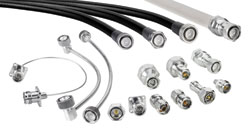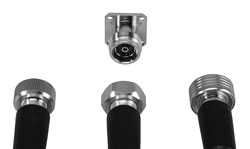
The choice between classical interfaces such as 7/16, N or 4.1/9.5 connectors and the new 4.3-10 interface can make a significant impact on how a particular network will perform. There are several considerations to make when choosing a connector, including the network design and the choice of the mobile telecommunications system used.
Because Long Term Evolution (LTE) networks feature an increased mobile data rate of 100 Mb/s, this higher transmission rate will expose PIM vulnerabilities in today’s networks with frequency division duplexing. 4G networks require superior network transmission fidelity, higher than previous generations. Network operators also face the challenge of maintaining customer loyalty in an unforgiving competitive arena. As such, good network PIM performance and PIM testing are now imperative. Indeed, the 4.3-10 connector satisfies the requirement of very low PIM performance and compactness, fitting into a 1" (25.4 mm) flange and being up to 60 percent lighter than some RF interfaces.
Features and Benefits
A key feature of this connector is the separation of the electrical from the mechanical plane. This implies another way of contacting the outer contact. The front contact force that is needed for interfaces like 7/16, N or 4.1/9.5 is not needed for the 4.3-10. That is because the contact is realized radially, which requires a lower force for the maximization of the contact points.

Figure 1 The 4.3-10 connector is available in hand-screw, screw and push pull versions.
The decoupling of the electrical from the mechanical plane means there is no need for a high torque value to achieve high electrical performances. Besides the screw version, the design can offer a hand-screw solution or a push pull design because of this feature. The coupling mechanism does not influence the PIM or return loss performance and all the three configurations – screw, hand-screw or push pull connectors (shown in Figure 1) perform the same. For better handling during installation, the hand-screw or push pull versions make it possible to rotate the cable and still have a secure connection.
The 4.3-10 connector interface is characterized by protected contact surfaces, thus making the connector more robust and even if not handled with the greatest care, it is possible to have optimal PIM performance. All three coupling mechanisms can meet the same universal jack (female), giving absolute flexibility to the end user to install the plugs (male) in the most convenient way. For those customers who prefer tool-less solutions, the hand-screw or push pull connectors are the best choice. The installation is very simple and intuitive and is especially suitable for multiple installations in very tight spaces.
As mentioned, the dimensions of the 4.3-10 connector enable the coupling to fit in a 1" flange, thus offering the opportunity to design high density modules. Also, the fact that the hand-screw and push pull type require no torque wrench renders possible the option to reduce the pitch itself to 1". Since only low or no torque is required, the board panel can be designed to be lighter and thinner.
Applications
Due to its properties, the 4.3-10 connector is suitable for numerous applications. For instance, in new base stations, the 4.3-10 can be used for interconnections in the remote radio head as well as an interface on the antenna and on the jumpers. The connectors can be used in multi-operator, multiband distributed antenna systems (DAS) where RF signals have to be combined, terminated or distributed to the antenna, as well as in small cell applications where it is particularly suitable for meeting the challenging space restrictions and electrical performance requirements.
With wireless data use increasing rapidly, network infrastructure, both in-building and outdoors, must support good coverage and bandwidth in order to handle and transport such large amounts of data. Also, signals of different wireless operators with different frequencies have to be accommodated and re-distributed to provide the best coverage without mutual interference. Therefore, signal quality and reliability is becoming a feature of differentiation for operators.
With today’s requirements for RF connectors such as compactness, robustness, easy installation and very reliable electrical performance, the 4.3-10 connector, with its excellent electrical performance independent of the torque applied, innovative and multiple coupling mechanism and compactness, provides significant customer benefits and therefore competitive advantages in communication systems.
HUBER+SUHNER AG,
Herisau, Switzerland,
+41 71 353-4111,
www.hubersuhner.com
